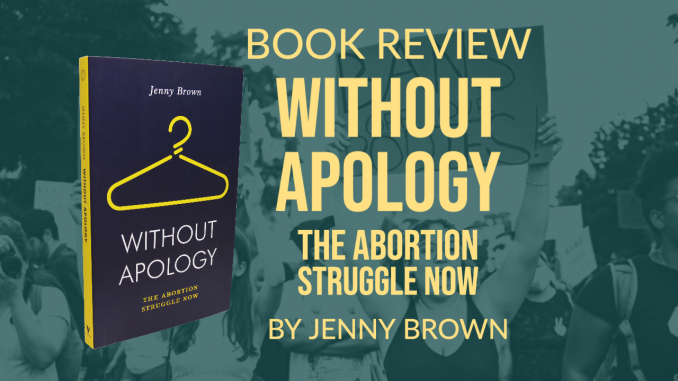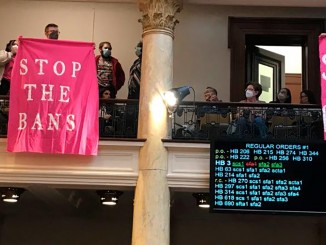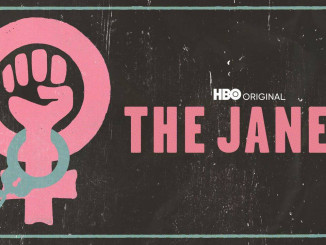
Save the Date! Jenny Brown, author of Without Apology: The Abortion Struggle Now will be speaking at our town hall on Sunday, September 25 at 4:00pm – 5:30 pm (pdt) (7:00pm – 8:30 pm (edt)). She will be discussing her book and the overall attacks on reproductive rights and a strategy for fighting back. Please join us.
Jenny Brown’s book Without Apology: The Abortion Struggle Now is a much-needed call to action as we struggle to respond to the barrage of attacks on reproductive rights since the Supreme Court overturned Roe v. Wade. With clear and direct language, this book exposes the strategic limitations that were deployed in the fight for reproductive rights that got us where we are today.
Brown contrasts the strategies and tactics used since Roe was passed with the fights waged in the 60s and early 70s that led to the Court’s decision to protect the right to an abortion. These were radical, bold, and aimed to address the needs of women’s liberation as a whole. Radical feminists led the charge and refused to play by the rules of a system rigged against them. Activists of that period challenged the foundations of society with broad goals. Based on their own self-activity they were able to win real gains. But Brown also points out that while the movement won many victories, its failure to change the current system, which has an interest in maintaining the oppression of women, has led us to face many of the same problems over again. The book identifies each thread of the problem and weaves these together, culminating in an argument that calls for the end of capitalism, and a broad, participatory, radical movement, capable of winning not only abortion rights, but the liberation of women and humanity.
What hasn’t worked
Brown’s introduction gets at the heart of the issue, pointing out the pitfalls in the fight for abortion. She recounts how activists were repeatedly told that the fight for abortion would require a “professional approach, a clever legal strategy, expensive polling research, a polished public relations campaign, and plenty of donations to groups that do these things.” But put into practice, this approach ultimately put activists on the defensive in losing battles. The problems with this approach, she points out, are that it pushes organizers to focus on the wrong things: on worst-case scenarios, and privacy. It avoids acknowledging the experiences of real women. By using words like “choice,” rather than naming and defending “abortion,” its messages lacked boldness and clarity, and gave the opponents of abortion an advantage.
Brown highlights these issues with a list of what she calls “unhelpful arguments”:
Unhelpful Argument #1: Abortion is about individual choice
She points out that the argument that abortion access is about privacy and the choice of the individual depoliticizes the issue, artificially isolating it from problems of access to health services, child care, or time off from work.
Unhelpful Argument #2: Abortion is not birth control
She argues that abortion IS birth control, and the people who attack access to abortion recognize this fact. Access to contraceptives is constantly under attack by the right, and, as far as contraceptives go, there is none as effective as abortion.
Unhelpful Argument #3: Abortion is a matter between a woman and her doctor; legislatures should not intervene
First of all, she points out that this assumes something false — that people have consistent access to healthcare and meaningful relationships to doctors. Secondly, not all doctors have the same views on abortion, and thus they are not necessarily partners to women seeking them.
Unhelpful Argument #4: Abortion is our right to privacy
She explains that the fight that won Roe was organized on the opposite basis, often encouraging women to break with the secrecy and shame surrounding abortion and share their stories. Activists organized consciousness-raising meetings and public speak-outs where people would “shout out their abortions,” sharing their experiences collectively. This built unity and made “the personal, political” while also putting real faces and people at the center of the fight for abortion, making it harder for critics to demonize them.
Unhelpful Argument #5: Abortion is not political
This she says is the logical result of the previous arguments, and that this approach is exactly what makes it impossible to fight effectively for women’s liberation. She reminds us that “political” questions have to do with power. And what is abortion access if not the power to control one’s body and live a healthy, productive life?
Her arguments give the reader a powerful scaffold, which the rest of the book builds upon. They challenge dominant ideas and arguments that are circulating in the mainstream, and force the reader to rethink what they may have taken for granted.
The Facts
The book is easy to read and packed full of useful statistics and historical facts that, when put together, build a clear picture of what the reality of abortion access has been throughout the years. Since the 1840s, she explains, 25-30% of women have had an abortion, regardless of legality. Seven out of ten of the women who have abortions are mothers. This, she posits, is not usually mentioned by abortion opponents because mothers are harder to demonize. She makes the case that abortion is the only contraceptive that is 100% effective. Furthermore, often those who are most responsible for unwanted pregnancies are men who aren’t obligated to deal with the repercussions of their actions. Also, the book patiently explains that today abortions are not the harrowing or risky procedures they may have been in the past, and often are done within the first weeks of pregnancy by taking some pills. It goes through the range of procedures available and shows to what extent current abortions are safe and mostly non-invasive. She effectively demystifies abortion, what it is, how it’s practiced, and why it’s necessary.
The History
Brown gives us an engaging and important historical background. Though patriarchal society has roots that take us back to the rise of property, in the U.S. anti-abortion legislation was passed only in the 1870s. This clamp-down on abortions occurred during a time when the male-dominated medical system sought to establish the supremacy of “the professional doctor.” Previously, abortions were commonly practiced by women, midwives or “docteresses.” As male doctors worked to establish themselves as the only authorities in the medical field, they sought to delegitimize and end age-old practices performed by women, who they considered inferior and of course, incapable of practicing medicine. At the same time, as corporations and industries expanded, and the ruling elite needed a larger workforce, it was no coincidence that there was also an increase in political pressure to restrict access to contraceptives and abortion.
The book also covers the history of the resistance and defiance against these laws. One of the most successful and powerful of these fights rose out of the 1960s, culminating in the passage of Roe v. Wade. She gives the context for this movement, one which was not isolated, but part of the general rebellion of the civil rights movement. One activist is quoted as saying, “[In the 60s] I wasn’t scared at all. I knew I was part of a movement that was backing me up.” It was a time when illegality held no one back, and injustices were being challenged in real time all over. Just as desegregation in the South wasn’t decreed from above but made a reality by people who would no longer stand for it, the feminist movement made change rather than waiting for it.
In the 60s feminist organizations formed across the U.S. to fight for the liberation of women from the oppressive forces of capitalism and patriarchy, and that fight included, but was not limited to, a fight for access to abortion. Some of the most prominent organizations from the time were the National Organization for Women (NOW) and the Redstockings who were groups that organized consciousness-raising groups and speak-outs. They organized for women’s liberation by having women share their experiences with one another and with the world. These consciousness-raising circles and speak-outs were able to destigmatize abortion and made issues that women had been told were individual, private matters, political concerns that involved the whole society. Also described are groups such as the Jane Collective in Chicago who organized women-run, illegal abortion clinics, which provided over 11,000 abortions. All this activity forced society at large to deal with these questions — making it impossible for the courts to ignore — and Brown’s telling of their heroism shines a light on the stark contrast between the meek, apologetic approaches often taken in the fight for abortion access today, which instead of fighting for free, unrestricted access to abortion, often focus merely on worst-case scenarios involving rape or incest, along with the matters of privacy, and choice.
There is so much more in the book, including a look at the history of all the restrictions to abortion access since the passage of Roe. Brown also gives insight into the recent successful struggle to legalize abortion and overturn the antiabortion Eighth Amendment of the constitution in Ireland. She includes some interesting commentary about reproductive rights in the former Soviet Union, and some other countries that Brown considers socialist or communist. While we don’t share her characterization of these countries as communist or socialist, her main point is crystal clear: it is possible to organize society differently in order to prioritize women’s reproductive freedom. Overall, this book has so much to offer anyone trying to make sense of the attacks on reproductive rights and the strategies needed to turn things around.
Roe Was Never Enough
While the Roe v. Wade decision was won by radicals who had broad aspirations, Brown argues that the weakness of contemporary pro-abortion activity stems from the weakness of Roe itself. Since the passage of Roe, she argues, there has been a misconception that the decision was won in the courts rather than by a fearless, often illegal movement. “Ignorance of the history of the earlier women’s liberation abortion struggle is leading us to underestimate the utility of organized feminism, and to exaggerate the utility of lobbying, toning down, and being respectable.” She calls Roe a “leaky, jerry-rigged decision” that never went as far as the feminists who fought in the 60s wanted. She points out the holes in Roe by recounting the endless string of legislation that immediately followed its passage, and has continued to this day; the chipping away at access to abortion, ruling by ruling, state by state — by Democrats and Republicans alike. Additionally, erasing the history and focusing pro-abortion activities on legalistic strategies put pro-abortion forces on a losing course right from the start. She states, “Even nonlawyers have been too focused on the legal angles and not enough on how to build a movement for reproductive freedom and justice. History indicates that where the movement leads, the courts will be dragged along.” That is the message reproductive rights activists should start from.
How We can Break Free
Brown weaves the stories of the feminist movement of the 60s throughout her book — along with other more contemporary stories such as the fight she helped wage for access to the Plan B pill (known as the ‘morning after’ pill) — building an argument for the kind of fight we need today. In her conclusion, under the header: A Women’s Liberation Strategy, she points out that the most important aspects of women’s liberation still have not been won because the primary obstacle in this struggle is the exploitative nature of the system of capitalism. Capitalism profits off the exploitation of the majority of humanity, and imposes various types of oppression to keep people divided, including the domination over women. She recounts, “The young radicals who started the women’s liberation movement in 1968 didn’t expect women could be free with capitalism intact.” She argues that the fight for abortion needs to be a fight for the liberation of women and humanity as a whole from a system which exploits us and denies us control of our lives.
Brown acknowledges that feminists have won many valuable things, such as greater respect for women, representation, better sex, and much more, “but on the points where employers and the rich would have to yield up money and power, we are still completely stuck.” Healthcare, childcare, shorter working hours, or the ability to have a family on a single parent’s income, she notes that these are all points on which we’ve lost ground. To gain ground, we will have to fight for an end to any restrictions on abortion access — legal, geographical, financial or otherwise. And to do this will require an end to restrictions on health care access, on access to housing, on access to a living wage, to education and more. Ultimately, she argues, women’s liberation will require a complete transformation of society, the end of capitalism and the liberation of people from exploitation. With this we wholeheartedly agree.




